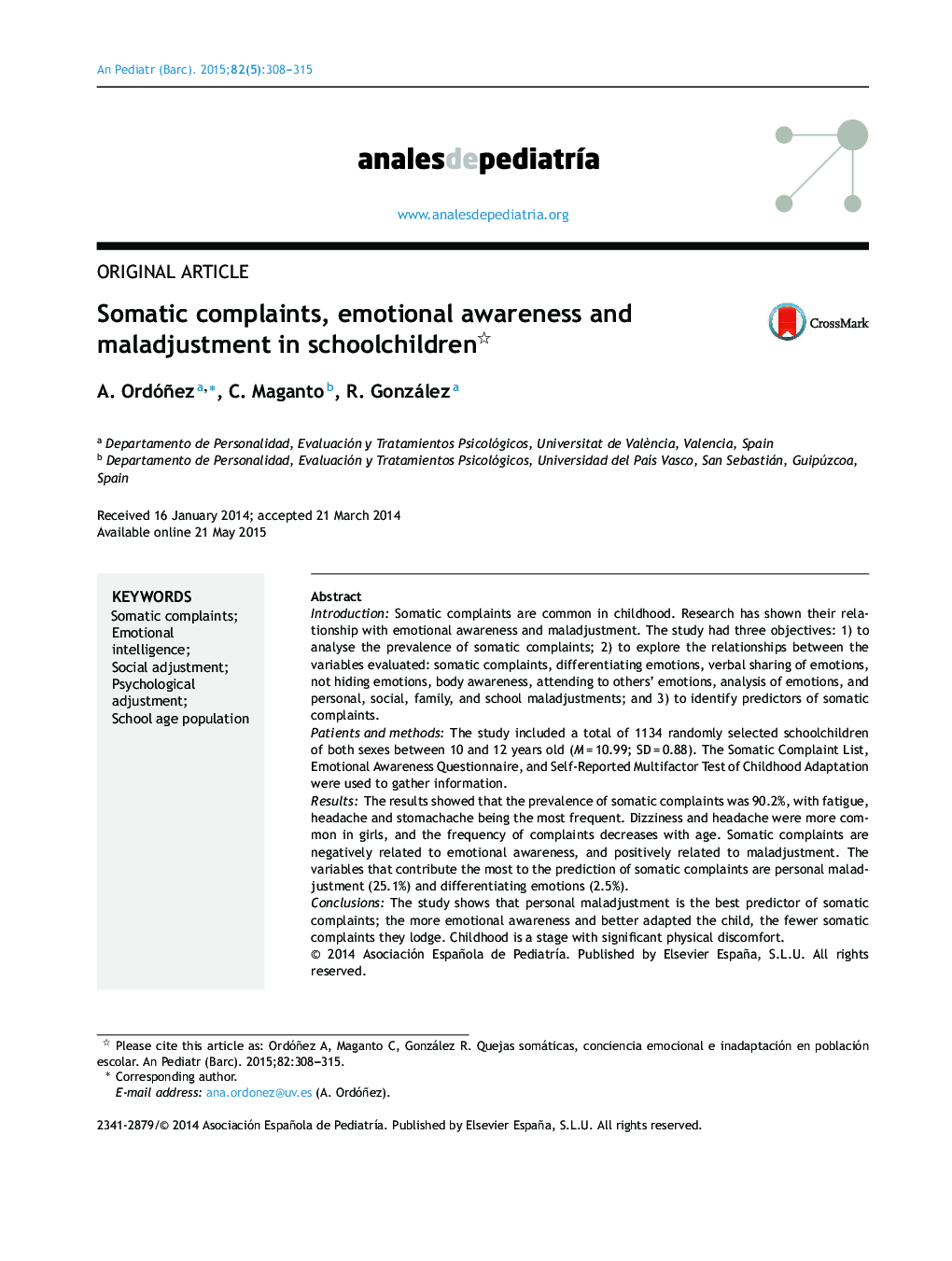| کد مقاله | کد نشریه | سال انتشار | مقاله انگلیسی | نسخه تمام متن |
|---|---|---|---|---|
| 4145262 | 1272598 | 2015 | 8 صفحه PDF | دانلود رایگان |
IntroductionSomatic complaints are common in childhood. Research has shown their relationship with emotional awareness and maladjustment. The study had three objectives: 1) to analyse the prevalence of somatic complaints; 2) to explore the relationships between the variables evaluated: somatic complaints, differentiating emotions, verbal sharing of emotions, not hiding emotions, body awareness, attending to others’ emotions, analysis of emotions, and personal, social, family, and school maladjustments; and 3) to identify predictors of somatic complaints.Patients and methodsThe study included a total of 1134 randomly selected schoolchildren of both sexes between 10 and 12 years old (M = 10.99; SD = 0.88). The Somatic Complaint List, Emotional Awareness Questionnaire, and Self-Reported Multifactor Test of Childhood Adaptation were used to gather information.ResultsThe results showed that the prevalence of somatic complaints was 90.2%, with fatigue, headache and stomachache being the most frequent. Dizziness and headache were more common in girls, and the frequency of complaints decreases with age. Somatic complaints are negatively related to emotional awareness, and positively related to maladjustment. The variables that contribute the most to the prediction of somatic complaints are personal maladjustment (25.1%) and differentiating emotions (2.5%).ConclusionsThe study shows that personal maladjustment is the best predictor of somatic complaints; the more emotional awareness and better adapted the child, the fewer somatic complaints they lodge. Childhood is a stage with significant physical discomfort.
ResumenIntroducciónLas quejas somáticas son frecuentes en la infancia. La investigación ha puesto de manifiesto su relación con la conciencia emocional y la inadaptación. El estudio tuvo 3 objetivos: 1) analizar la prevalencia de las quejas somáticas; 2) explorar las relaciones entre las variables evaluadas: quejas somáticas, diferenciar emociones, comunicar verbalmente emociones, no esconder emociones, conciencia corporal, atender emociones de otros, análisis de las propias emociones, inadaptación personal, inadaptación social, inadaptación familiar e inadaptación escolar, y 3) identificar variables predictoras de las quejas somáticas.Pacientes y métodosLos participantes, seleccionados aleatoriamente, fueron 1.134 escolares de 10–12 años (media ± desviación típica = 10,99 ± 0,88), de ambos sexos. Se aplicaron el Listado de quejas somáticas, cuestionario de conciencia emocional y el Test autoevaluativo multifactorial de adaptación infantil.ResultadosLos resultados indicaron que la prevalencia de quejas somáticas es del 90,2%, siendo el cansancio, el dolor de cabeza y el dolor de estómago los más frecuentes. Los mareos y el dolor de cabeza son superiores en niñas y las quejas disminuyen con la edad. Las quejas somáticas se relacionan negativamente con la conciencia emocional y positivamente con la inadaptación. Las variables que más contribuyen en la predicción de las quejas somáticas son la inadaptación personal (25.1%) y diferenciar emociones (2.5%).ConclusionesEl trabajo permite concluir que la inadaptación personal es la mejor predictora de las quejas somáticas, así a mayor conciencia emocional y mejor adaptación, menor es el número de quejas somáticas presentadas, siendo la infancia una etapa evolutiva con importante malestar físico.
Journal: Anales de Pediatría (English Edition) - Volume 82, Issue 5, May 2015, Pages 308–315
